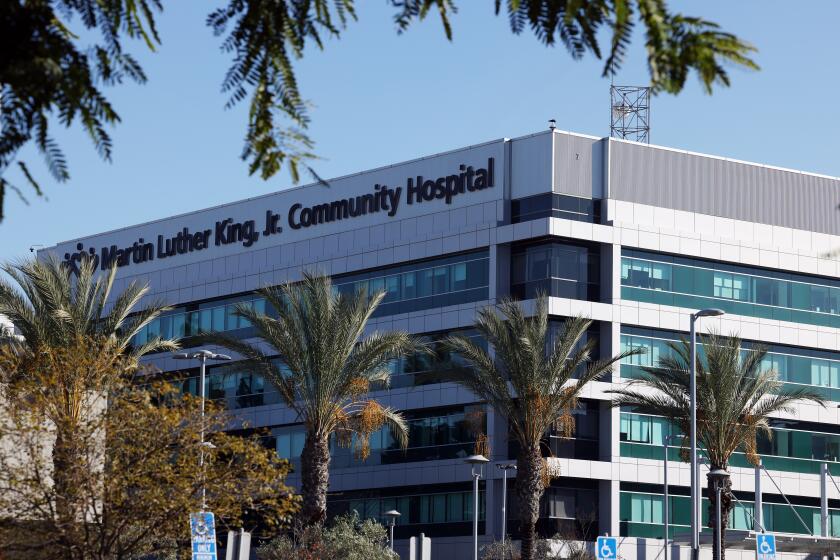Why are so many California hospitals closing their labor and delivery units?

- Share via
Last week, Keck Medicine of USC announced the closure of USC Verdugo Hills Hospital obstetric services on Nov. 20. They cited a 40% decline in deliveries over the past decade within “our community” and the resulting financial effect on the hospital as reasons for the decision. While this justification appears reasonable at first glance, it conceals an unsettling trend with significant implications for maternal health.
The closing of hospital labor and delivery units is a nationwide trend, resulting in “maternity care deserts.” The closures primarily affect patients with Medicaid insurance, which pays for more than 40% of deliveries in the United States, and through Medi-Cal, more than 50% of deliveries in California. Unequal access to obstetric care contributes to America’s shamefully high maternal mortality rate which, at 22 maternal deaths per 100,000 live births in 2022, was double or triple the rate of peer nations.
Obstetric care is different from many other types of healthcare in its unpredictability. Babies do not arrive on anyone’s schedule, and the busyness of labor and delivery units can wax and wane accordingly. For doctors to care for laboring mothers and their babies safely, hospitals must be staffed for the possibility of a sudden abundance of patients requiring emergency care.
Martin Luther King Jr. Community Hospital is the keystone of Los Angeles County’s effort to meet the needs of a population struggling with poverty and poor health. Keeping it open is essential.
The modern fee-for-service healthcare model, which pushes hospitals to maximize efficiency and reduce staffing, treats the resiliency necessary for delivering babies as a drag on their bottom line. In this model, hospitals must fund round-the-clock capacity but are only reimbursed when their facilities and staff are in action. So if not enough deliveries are happening, expenses outweigh reimbursement. This drives hospitals to get out of the baby delivery business altogether.
California has experienced a higher rate of obstetric unit closures than other states, and it continues to accelerate. More than 46 labor and delivery departments closed in the state between 2012 and 2023, with 60% occurring within the last three years. These closures are not limited to sparsely populated rural areas: 17 were within Los Angeles County, resulting in a local rate of closures that far outpaces the declining birth rate. This year, five more California hospitals have stopped providing obstetric care, and USC Verdugo Hills Hospital will be the fifth in L.A. County to close labor and delivery within a two-year period.
Healthcare and medical benefit administrators talk of scaling and consolidation, of concentrating obstetric care at fewer hospitals so that there will be enough deliveries to cover the expense of remaining open. This will only work if we assume that market forces will sort out the balance between supply and demand so enough labor and delivery departments remain open to meet demand. But such forces only work if prices are dynamic and responsive to changes in supply. Insurance providers, especially Medicaid and Medi-Cal, have not shown this type of flexibility.
Medi-Cal, the Medicaid program in California, has reimbursement rates for obstetric care that are fifth lowest in the nation. In our state, even busy labor and delivery departments that care primarily for Medicaid patients do not break even. South L.A.’s Martin Luther King Jr. Community Hospital is struggling to stay open despite increasing its volume of obstetric patients as other Los Angeles labor and delivery units have closed. This shows that the amount paid by Medi-Cal is below the market cost of providing obstetric care. This deficit is at the core of the California closures.
We need to end a culture of obstetric racism that has resulted in a maternal mortality rate for Black women that is around three times that of white women.
There are at least two paths forward.
The first is to increase Medi-Cal’s reimbursement of each delivered patient. The second would require directly regulating and subsidizing the maintenance of labor and delivery units the way the state does for emergency rooms. Either approach will be costly, because providing safe, modern, evidence-based obstetric care is expensive.
Reproductive freedom is much in the news this campaign season. It should include reasonable, safe and dependable access to labor and delivery services.
Anna Reinert is an assistant professor of clinical obstetrics and gynecology at USC’s Keck School of Medicine.
More to Read
A cure for the common opinion
Get thought-provoking perspectives with our weekly newsletter.
You may occasionally receive promotional content from the Los Angeles Times.











